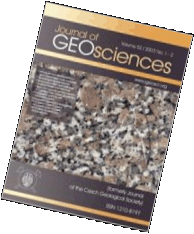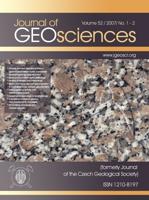 Export to Mendeley
Export to Mendeleyhydrothermal mineralization
Western Carpathians
boudinage
transpressive shear zone
rheology
deposit
Original paper
Boudinage arrangement tracking of hydrothermal veins in the shear zone: example from the argentiferous Strieborna vein (Western Carpathians)
Journal of Geosciences, volume 64 (2019), issue 3, 179 - 195
DOI: http://doi.org/10.3190/jgeosci.291
Argentiferous Strieborna vein of the Rožňava ore field occurs at the southwestern margin of the Gemeric Unit (Slovakia). The hydrothermal mineralization of the vein closely related to the Early Cretaceous tectonometamorphic shortening of the Western Carpathians. For their emplacement, the vein used the steeply dipping, fan-like cleavage and dislocation set of the Alpine regional structure. Successively the vein was integrated into the sinistral transpressional regime of the Transgemeric shear zone. A polyphase vein filling comprises Variscan metasomatic siderite remnants and the Early Cretaceous syntectonic hydrothermal mineralization, the latter consisting of two mineralization phases, quartz-siderite and quartz-sulphidic. During Cretaceous shear zone transpressional events, the vein was segmented into five individual bodies and redistributed to kinematically and geometrically different tensional and compressional boudins. The vein asymmetry increase, different vertical mineralization content and spatial distribution of mineral phases representing individual mineralization periods directly relate to a rheological contrast between the vein and surrounding rocks stress and pressure shadows distribution. The actual form and distribution of the Strieborna vein segments is the product of four boudin evolution stages: (1) pre-deformation, (2) initial, (3) boudin-forming and (4) boudin-differentiation stage that controlled vertical mineralization distribution. The sulphidic mineralization is dominated by two generations of argentiferous tetrahedrite and two youngest sulphosalts associations enriched by Sb and Bi. The youngest sulphosalts of the stibnite phase at the Strieborna vein resemble contemporaneous mineral associations at the nearby Čučma stibnite vein lode. Both vein occurrences located within the Transgemeric shear zone belong to the Rožňava ore field and they are cut by the same diagonal strike-slip fault. These analogies indicate a similar genesis of terminal associations at both these vein deposits. Results of the Strieborna vein sulphosalts spatial analysis confirm their vertical zonation. The Sb and Ag contents decrease, while Bi contents increase, with depth and conserve boudin evolution stages created in distinct rheological environments. The vertical boudin arrangement concentrates economically most prospective parts into asymmetric boudin tension shadows.
Webdesign inspired by aTeo. Hosted at the server of the Institute of Petrology and Structural Geology, Charles University, Prague.
ISSN: 1803-1943 (online), 1802-6222 (print)
email: jgeosci(at)jgeosci.org


IF (WoS, 2024): 1.3
5 YEAR IF (WoS, 2024): 1.4
Policy: Open Access
ISSN: 1802-6222
E-ISSN: 1803-1943